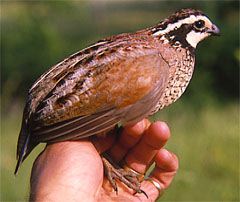THIS WEEK at HILTON POND
15-21 May 2004
Installment #223---Visitor #
(Back to Preceding Week; on to Next Week)
|
GREEN FROGS Back in the 1980s, it was not uncommon on a midsummer's night to hear the basso profundo of Bullfrogs thundering from the banks of Hilton Pond. "Mmmwwongg" was how they always sounded to our ears, although some folks claim these big amphibians say "jug-o-rum." Regardless of the lyrics, the Bullfrog's song seldom breaks our nighttime silence any more, and rather than several big males competing with ever-louder calls, we're lucky to hear even one in the course of the breeding season. We suspect the demise of local Bullfrogs was caused in part by drought-induced loss of shallow water where their tadpoles could develop, and undoubtedly weed-eating Grass Carp that were dumped into Hilton Pond 15 years ago consumed so much aquatic vegetation that Bullfrogs and their young had nowhere to hide from Largemouth Bass and other predators. Now that the water level is back up and the carp have pretty much died out, we're hopeful both submerged plant life and our Bullfrogs will return. In the meantime, we content ourselves with listening to and watching the antics of the Center's ever-growing population of Green Frogs--smaller cousins of the Bullfrog.
All text & photos © Hilton Pond Center Green Frogs and Bullfrogs are similar in appearance and are often misidentified. The genus epithet they share--Rana--is the Latin word for "frog." R. catesbeiana, the Bullfrog, is named for early naturalist Mark Catesby, and reaches lengths of up to 6" from snout to vent. Green Frogs, R. clamitans (meaning "loud-calling"), seldom have bodies longer than four inches. The hind legs of both species are proportionally long--usually longer than the body itself.
Quite commonly the Green Frog has a lime green upper lip (above), but color on the remainder of the dorsal surface varies from dark olive brown to bright green to tan. In fact, herpetologists recognize separate subspecies based in part on color, with Rana clamitans melanota being the Green Frog and R. c. clamitans the tan-colored Bronze Frog, which has a more southeasterly distribution and bears no blotches on the back. Other than the legs, the most obvious external structures on a Green Frog are its eyes, which are so large they're practically outside the animal's skull. The eyes are so positioned that out of the water a frog can see in front of, beside, and directly behind itself--one reason it's so hard to sneak up on one while it sits on the pond bank. In Green Frogs, as in Bullfrogs, there is a prominent external eardrum behind each eye. This tympanum is equal in size to the eye in females, but noticeably larger in males. We've always found this to be curious because in both species it is the males that call, and females that locate the most promising male by sound. (Perhaps males need bigger ears to keep apprised of the quality and intensity of their competitors' vocalizations.) Unlike the Bullfrog's drawn-out "mmmwwongg," the primary mating call of the Green Frog is a deep, abrupt "guungk" that some listeners liken to the twang of the lowest string on a banjo. They make several other sounds, including a high-pitched squeek when they are startled and leap away. Green Frogs, which occur across the entire eastern and central U.S. and even southern Canada, usually breed from April through mid-summer when females move toward calling males. As is often the case in the animal world, mate choice among Green Frogs is made by the female, who probably bases her selection on quality and size of the habitat being defended by a male. After the male mounts a receptive female, he may stay clasped to her for several hours--even days--holding on with stout forelegs and thickened thumbs. This lengthy "amplexus" continues until the female releases her eggs and the male fertilizes them externally. A large female Green Frog may lay as many as 7,000 jelly-covered eggs that clump around vegetation in shallow water. Although Bullfrogs generally seek larger aquatic habitats, Green Frogs are as just as likely in smaller permanent impoundments, where adults eat a variety of invertebrates and their tadpoles eat algae. Just outside the office window at Hilton Pond Center we have a year-round water garden made of two connected 4' X 5' pools containing Pickerelweed and Water Lilies and surrounded by large flat rocks. Almost any day from last frost through October we see several Green Frogs--and occasionally a Bullfrog or two--all perched around the pools, sometimes sitting for hours without moving until an appetizing insect flies too close. Then in a flash the Green Frog lunges forward, flips out its rear-hinged tongue, grabs the prey item, and pulls its eyeballs into their shallow sockets to help force the insect down its throat. Having hunted successfully at Hilton Pond Center, the Green Frog returns to its perch, where it remains motionless until the next insect appears or hormones cause it to come forth with that distinctive, twangy, one-syllable "guungk."
Comments or questions about this week's installment? NOTE: Be sure to scroll down for an account of all birds banded or recaptured during the week, as well as some other interesting nature notes. "This Week at Hilton Pond" is written & photographed You may wish to consult our Index of all nature topics covered since February 2000. You can also use the on-line Search Engine at the bottom of this page. For a free, non-fattening, on-line subscription to "This Week at Hilton Pond," just send us an E-mail with Subscribe in the subject line. Please be sure to configure your spam filter to accept E-mails from hiltonpond.org.
|
|
Make direct donations on-line through
Network for Good: |
|
|
LIKE TO SHOP ON-LINE?
Donate a portion of your purchase price from 500 top on-line stores via iGive: |
|
|
Use your PayPal account to make direct donations:
|
|
|
|
|
SPECIES BANDED THIS WEEK: * = New species for 2004 WEEKLY BANDING TOTAL
YEARLY BANDING TOTAL
BANDING GRAND TOTAL NOTABLE RECAPTURES THIS WEEK NONE THIS WEEK
|
OTHER SIGHTINGS OF INTEREST
--On 18 May we saw the probable parent birds for the covey of half-grown Northern Bobwhite that we observed last week at Hilton Pond Center. The adult male (above) is distinguished by white facial markings that are buff-colored in the female. Because they are game birds, we are not permitted to band bobwhite. --Hilton Pond is beginning to suffer what we hope is only a "mini-drought." No significant rain has fallen in more than two weeks and the situation is beginning to remind us of the severe five-year drought that was finally broken in 2003. --Banding efforts at the Center were diminished significantly when the master bander had major eye surgery on 19 May. Further research is on hold until recuperation is complete.
|
(Back to Preceding Week; on to Next Week)
|
|
|
Up to Top of Page Back to This Week at Hilton Pond Center Current Weather Conditions at Hilton Pond Center |
 You can also You can alsopost questions for The Piedmont Naturalist |
Join the |
Search Engine for |
|
|
Dell Axim Computers
The link above is required by a Web site that provides us with a free page counter.
You are not obligated to click on the link.

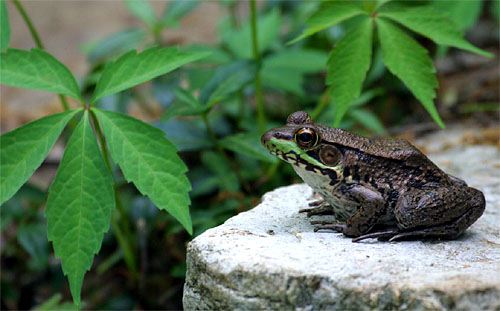
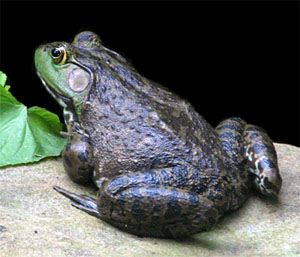 Providing leverage for these enormous jumping legs is a rigid framework composed of a winged sacral vertebra and two attached ilial bones--a structure so well-developed it forms visible protrusions on the frog's back. Often these sacral bumps are more pronounced in the Bullfrog, but the best way to differentiate Bullfrogs from Green Frogs is to look for a long dorsolateral fold in the latter. This ridge of skin begins just behind the eye of the Green Frog (top photo and just below) and extends to where the hip bones protrude; the fold is absent in Bullfrogs (above right). Other than that, the color patterns and external anatomy of these closely related species can be very similar.
Providing leverage for these enormous jumping legs is a rigid framework composed of a winged sacral vertebra and two attached ilial bones--a structure so well-developed it forms visible protrusions on the frog's back. Often these sacral bumps are more pronounced in the Bullfrog, but the best way to differentiate Bullfrogs from Green Frogs is to look for a long dorsolateral fold in the latter. This ridge of skin begins just behind the eye of the Green Frog (top photo and just below) and extends to where the hip bones protrude; the fold is absent in Bullfrogs (above right). Other than that, the color patterns and external anatomy of these closely related species can be very similar.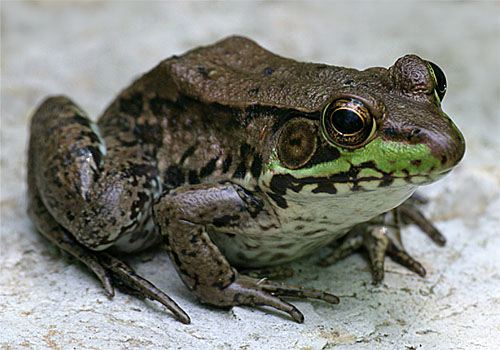
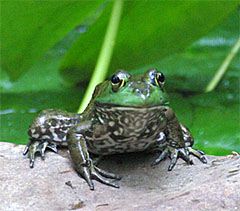 These subspecies probably interbreed where their ranges overlap, resulting in intergrade coloration and markings. Representatives of either subspecies have white bellies with varying amounts of dark spots; some individuals have completely white chins while in others the reticulation covers the entire ventral surface (above left). Breeding male Green Frogs are reported to have bright yellow chins, but at Hilton Pond Center we've only seen pale yellowing along the lower lip (bottom photo). All said, Green Frogs exhibit a tremendous amount of variation in appearance--so much so that individuals can be identified in the field.
These subspecies probably interbreed where their ranges overlap, resulting in intergrade coloration and markings. Representatives of either subspecies have white bellies with varying amounts of dark spots; some individuals have completely white chins while in others the reticulation covers the entire ventral surface (above left). Breeding male Green Frogs are reported to have bright yellow chins, but at Hilton Pond Center we've only seen pale yellowing along the lower lip (bottom photo). All said, Green Frogs exhibit a tremendous amount of variation in appearance--so much so that individuals can be identified in the field.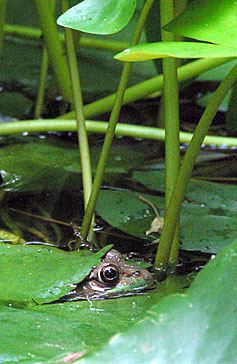 Additionally, the eyes are almost on top of the head, which allows a frog to hide nearly submerged in water with only its eyeballs and nostrils exposed (below right).
Additionally, the eyes are almost on top of the head, which allows a frog to hide nearly submerged in water with only its eyeballs and nostrils exposed (below right).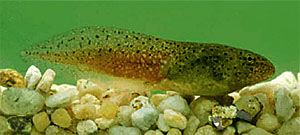 The eggs hatch within a week or so, but some resulting tadpoles may take up to 22 months to metamorphose into tailless subadults--a sign that some future Green Frogs overwinter as fat, two-inch long tadpoles (above left). The same is true of Bullfrogs, requiring both species to lay their eggs in permanent bodies of water rather than temporary vernal pools used by some salamanders and many smaller frog species. Incidentally, Green Frogs typically overwinter buried in aquatic mud, where they breathe through their skins.
The eggs hatch within a week or so, but some resulting tadpoles may take up to 22 months to metamorphose into tailless subadults--a sign that some future Green Frogs overwinter as fat, two-inch long tadpoles (above left). The same is true of Bullfrogs, requiring both species to lay their eggs in permanent bodies of water rather than temporary vernal pools used by some salamanders and many smaller frog species. Incidentally, Green Frogs typically overwinter buried in aquatic mud, where they breathe through their skins.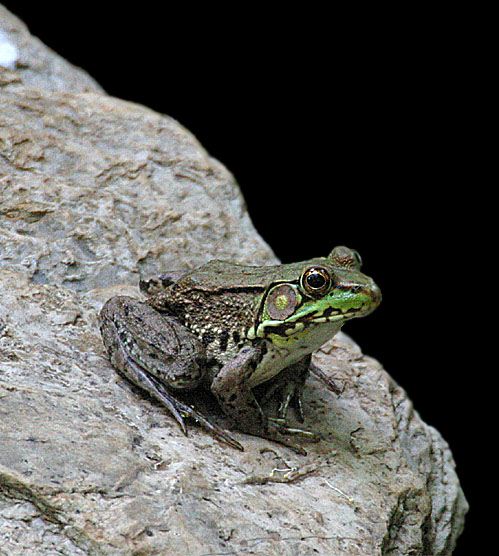



 Please report your
Please report your